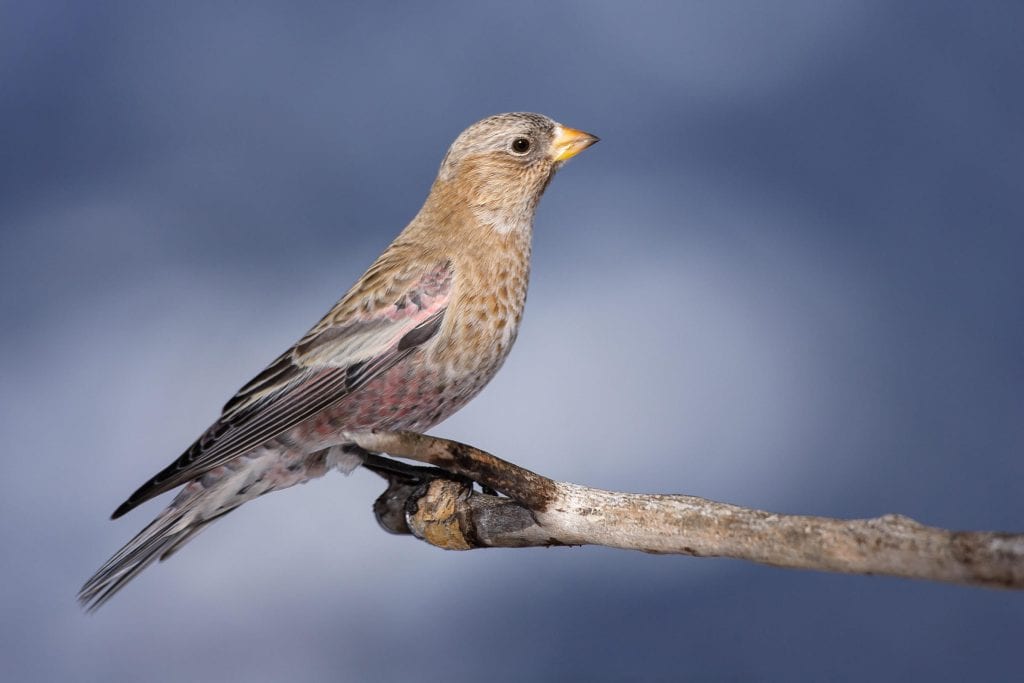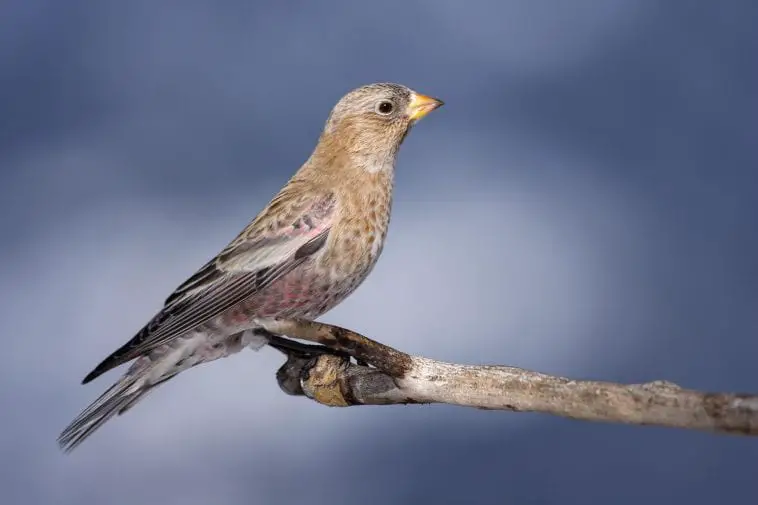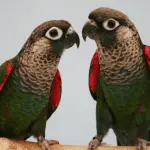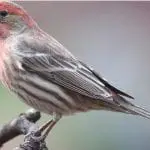Scientific facts
| Scientific name: | Leucosticte australis |
| Mass: | 27 g (Large Adult) |
| Phylum: | Chordata |
| Higher classification: | Mountain finch |

Description
Like the further rosy-finches, the Brown-capped Rosy-Finch is a bird of the high foothills, breeding directly above timberline. It has the least variety of the three American class, being found chiefly in Colorado.
Habitat
Rosy-finches in over-all are birds of the Arctic and alpine regions; nonetheless, this one lives the high mountains of the Rockies from Wyoming south to New Mexico. Even where thoroughfares take the spectator to parts above the tree line, this type can be indefinable in summer, appearing to favor the most distant and unfertile cliffs and remote snowfields. In wintertime, when the birds change to inferior elevations, they are frequently much easier to find, even approaching to feeders in vale municipalities.
Eggs
3-5. White, spotless. Gestation is by female solitary, around 12-14 days. Young: Equally, parents fodder the nestlings. Young leave the layer around 18 days after crosshatching, and may continue with parents concluded end of summer besides into the fall. 1 offspring per year.
Nesting
From top to bottom elevations where this bird layers, snow might cover nesting places until late June in some ages. Birds might be previously paired when they reach breeding parts. Nest place is in a gap or hole in an aspect, occasionally a very narrow gap where the layer is fairly inaccessible, occasionally under a pillar, in mine tube, or unrestricted building. Nest (constructed by female) is a large cup of moss, grassland, wildflowers, rootlets, furrowed with fine grass, and occasionally with feathers or animal fur.
Fun Facts
It typically takes a female Brown-capped Rosy-Finch 1 to 3 days to concept a nest (the male does not support). At one place, though, edifice took 18 days since wind detached the nest twice. The additional female took 11 to 14 days to shape her nest since the nest substantial kept sliding off the slanted nest shelf.
The Brown-capped Rosy-Finch outlines its nest with grassland, feathers, besides fur. It likewise has been chronicled through cotton, bits of cloth, raveling of burlap, besides, in one layer, a portion of blasting fuse.
Rosy-finches shape their nests in cracks where they stay totally in the shadow. One Brown-capped Rosy-Finch nest was ice-covered in ice apiece evening when the water dripping through the location fixed.
The oldest chronicled Brown-capped Rosy-Finch was a male, in addition to at least 5 years, 11 months old when he was recalled and redistributed throughout banding processes in Colorado.
Distribution
Rosy-finches breed at the uppermost height of any type north of the Mexican boundary in North America, typically nesting on precipices running glaciers in addition to snowfields on the highest mountains, and above the fields and tundra visited by further alpine bird types. The Brown-capped Rosy-Finch is the southernmost of 3 carefully connected types on this landmass and has the minimum delivery, being nearly widespread to Colorado. It is to the most distinguishing, with rosy insignia casing more of its form than in other types and missing the clear gray hue on the cranium that is so typical of the other types. It is likewise the most sexually dimorphic in hue.
In summer, this type is most often seen scavenging on insects ice-covered on the shallow of snowfields and kernels unprotected along with the receding limits of the snow. In wintertime, severe squalls and deep sleet drive individuals down to lesser heights, where they have perceived in big flocks laterally the snow-free limits of infrastructures, on phone cables, and at feeders.
In the evening, they perch in old Cliff Swallow (Petrochelidon pyrrhonota) layers, outbuildings, and caves that deliver guard from wintertime cold. Nevertheless, even in the coldest of seasons, they appear to favor the highest heights where nourishment can be created and will travel on a day-to-day basis up to mountainous tundra when temperatures are –35°C if breezes have bare shares of the tundra and edges for feeding.
Breeding
The breeding ecology of this type is rare in that males chiefly protect a floating land around their mates, somewhat than about a fixed part of alpine real land. This is theoretical to consequence from a tilted sex relation with females in short source; nonetheless, the inquiries of mating structures, sex relations, and the conceivable part of nonbreeding males all merit further learning.
Availability and where to get one
You will be able to ask for some referrals and recommendations from your local bird breeders. There are also pet shops that cater to such kinds of birds.
Personality & Behavior
Finches are general as mate pets since of their enjoyable sounds and social connections with their flock mates, besides, in the case of the Gouldian finch, their stunning pattern. They have typically detached pet birds; in its place favoring to be with further of their kind.
Speech & Sound
Finches are not proficient in producing the ear-splitting shrieks of parrots and consequently might make a decent choice for individuals with nearby neighbors. Their languages are typically “peep” and “meep” noises, characteristically by the males. Their cries/songs can be tenacious sometimes, and finches spend a big share of their day outspokenly interactive with one another.
Common Diseases
1. Feather Loss
2. Stress
The most common reason for feather damage in finches is pressure.
Is there one more bird that is irritating him or her? If consequently, then unraveling might help. Competition can chiefly occur throughout the breeding period.
Other than exterior influences, it could likewise be undernourishment that is producing pressure on a bird’s structure. The commendations then are to advance régime (a good excellence dry finch combination, egg nourishment, for example, mashed simmered egg with the shell, grated carrots, veggies such as cucumber, cabbage, and herbs, etc.
upsurge sunlight exposure (to logically upsurge Vitamin D, also recognized as the sunshine vitamin)
3. Parasites
If numerous birds were trailing feathers, one would doubtful a conceivable worm and/or protozoal contagions, which would require to be treated. Not as much of probable if it’s only one finch.
4. Iodine deficiency
Chiefly common in Australian finches, nonetheless not exclusively
Iodine is mandatory for the good working of the thyroid gland. Iodine absence can consequence in poor feather disorder, trouble molting, breathing, and sterility difficulties. Predominantly Australian finches (for instance, Gouldian’s) have a higher prerequisite for iodine. Iodine can be provided by totaling grated cuttlebone on their vegetations, grown seed, or egg food enhancements.
Oyster shell is an additional great foundation of iodine. If natural nourishment bases are not sufficient, then the following step would be to increase with Liquid Iodine, Natra-Kelp, or Powder Kelp. Though, natural food bases are continuously harmless and should be nourished first, beforehand using supplements. Balding outline in maximum cases on the cranium. If, after 3 weeks of adding the feathers are not imminent back, iodine shortage is not the reason.
5. Hormonal / Breeding
Feather loss can also be instigated by hormonal difficulties in hens or breeding birds out of period.
Feather Loss from Cranium- Feather mites or violence by other birds in its situation.
6. Respiratory Signs, Chronic Despair, Weight loss
Aspergillosis (fungal illness), microbial contagions/pneumonia, nutritious deficits (Hypovitaminosis A), air sac mites (Gouldian Finches), upper respiratory tract contagions (bacteria, mycoplasma), Polyoma Virus or inhaled contaminants.
Genetic Illnesses – Affecting chiefly change and/or in-bred finches (Gouldians / Zebras)
Masses on Legs and Feet (Scaly Leg Illness) – can be produced by Knemidokoptes mites (particularly European Golf Finches), bulge from strangled threads, or insect bites.
7. Eye Difficulties / Conjunctivitis
Herpes virus contagion; Mycoplasmal Conjunctivitis or Blepharitis
8. Scaly Face Mites
9. Scaly Legs
Knemidokoptes mites, nonetheless may likewise hereditary or nutritional
10. Droppings
Seed in Mucks – Cochlosoma contagions, Vitamin E or selenium absence, enteritis, lack of grit.
Big White Mucks – Campylobacteriosis, pancreatic inadequacy
11. Aspergillosis
This disease is a fungal contagion produced by mold. The disorder reasons respiratory distress and can be deadly if not preserved immediately. Signs comprise variations in breathing, breathless, wheezing, or an alteration in speech for vocal birds.
See your vet as rapidly as conceivable if you notice these indications. Treatment is extended and hard with medicine. Make certain the bird’s birdcage and zones are dry so mildew cannot produce.
12. Fractures and Breaks
Legs and wings can be cracked or broken. Though some individuals may know to generate splints for the limbs or setting the wing for the wound to heal, these responsibilities are finest left for your avian vet. Skewed splints or wing rearranges can reason further injury.
13. Egg Binding
Some eggs might be problematic to permit and cause irritation. The egg might also be partly noticeable, and the bird may fold its tail throughout this period. If you delay one or two hours, the egg must pass. If the egg does not permit, contact your vet. Be cautious not to touch the egg or the part; grave injury or demise to the pet is conceivable.
14. Eye Inflammation
This eye illness is characteristically produced by a miniature feather rising from the eyelid; nonetheless, it can similarly be produced by wreckage or a foreign thing. If you can perceive the nuisance, you can try to eliminate it. If no pain is noticeable, it is probable to be a contagion. Flush the eye with warm liquid and apply an eye cream.
Best Set-up for a Sick Bird
Initially, the birdcage needs to be kept exactly clean — this is particularly significant when it keeps a sick bird that cannot deal with microorganisms as well as a strong one might.
EXCEPT your pet is consecutively a temperature, WARMTH IS DANGEROUS! Providing your pet is NOT running a temperature; its setting should be reserved at around 90 degrees. In cases where a domesticated bird does have an infection, you don’t want to upsurge the ambient (area) temperature more as it would increase your pet’s temperature even further – and that alone could be deadly. A chilled bird will be bungled up. An overheated bird will raise its wings away from its physique and possibly wheeze.
A hospital birdcage would be prodigious, as it would save the temperature at the level you need. Nonetheless, most individuals don’t have that obtainable, and an acrylic bird carter or fish tank obtainable at pet stores can be relieved. If you’re using one of those, you have to display the temperature fairly carefully. This being supposed, putting an ill bird into a new situation may be demanding. Perhaps placing the birdcage into a small area that can effortlessly be heated (small lavatory, for instance) might do.
Drape a weighty shelter on one of the edges, but make certain that the bird doesn’t “sit down in the dim” — excluding at night. Possible heat bases can be a heating pad beneath the birdcage, hot bottles, or heat spots. The heat spotlights shouldn’t be used in the evening, as your pet needs to respite. Maybe a mixture of heating cloth in the evening and a heat lamp throughout the day might be a selection. Prepare whatever works finest for you.
Look out for desiccation (indications and procedure below).
- Make certain that all food and water cups are within easy range.
- Reduce pressure as much as conceivable. This might mean minimalizing treatment and removing additional birds from the birdcage. It is vigorous that the sick bird has at least 12 hours of uninterrupted break per day.
- Keep any roosts low to decrease wound from falling.
- Sick birds might advantage from live bird-precise probiotics that decrease the production of communicable, pathogenic gut microorganisms, and improve the immune system. Birds that have experienced antibiotic handling in specific need to substitute beneficial microorganisms that were devastated throughout the treatment.
Emergency Nourishment for Sick Birds / Evade Dehydration
Birds suffering from desiccation may have creased casing around their eyes. An additional way to identify desiccation is to tweak their casing for a second (which is likely in chicks or birds with unfeathered parts on their forms). The dehydrated casing will persist tented for more than a few seconds, somewhat than bouncing right back.
The ill bird has low plasma and energy stages that must be reinstated quickly.
Preventing Dehydration:
- Fresh, unsoiled water must be obtainable at all times.
- Adding tiny honey to the liquid may heartening drinking; though, the water needs to be altered often as microorganisms grow easily in sweet water
- Commercial electrolyte additional fluids (i.e., Pedialyte) will likewise help stop dehydration – the main danger an ill bird face. When caring for an ill bird, I substitute the liquid with Pedialyte, which will counter any dehydration.
- Treat Desiccation:
- To remedy desiccation use:
- commercial electrolyte liquids, for example, Pedialyte; or
- blend one pint of liquid, one nip of Gatorade, 1 teaspoon of honey or Karo molasses, 1 equal teaspoon of aluminum-free baking soda (for example, “Bob’s Red Mill Baking Soda”), 1 equal teaspoon table salt.
Caution: Amount with care; imprecise quantities can reason severe diarrhea. Orange or cherry juice aids in hydrating your bird.

Care Sheet
How do I set up a finch home?
Birds are communal creatures. Finches of the similar type and scope can be housed in couples or flocks. Their inclusion must be big enough for finches to bounce their wings, ascent, and play.
Select an enclosure that’s no less than 12 x 12 x 15 inches (30 x 30 x 38 cm); the further birds that animate in the inclusion, the bigger it must be.
Place the inclusion at or under your eye level.
Birds are subtle to strong odors, smoke, and breezes. Retain the inclusion out of the kitchenette and away from gaps and entrances.
Layer the lowest of the inclusion with aspen splinters, wood bits, recycled newspaper, or a liner. Change or unsoiled the bottommost of the inclusion no less than once monthly.
Provide a low bowl of water for finches to cleanse in, or mildly spritz them with warm liquid two or three times a week.
Encourage scavenging by engaging a straw ball in the inclusion.
Finches must likewise have a cuttlebone or mineral block to preserve a strong beak and provide calcium for robust bones.
Birdcages should be situated in quiet parts with low foot circulation to diminish strain on the birds. Birdcage linings are typically broadsheet or kraft paper. Assume to unsoiled the birdcage weekly and completely sterilize the birdcage once per month.
Finches are not big enthusiasts of toys; nonetheless, they do like roosts and swings. Since the birds fly level, make certain these matters do not delay or chunk the flight trail. Retain them away from nourishment and water bases, so falling mucks do not pollute their nutritional items.
Wood cannot be clean once mucky by droppings, so non-poisonous hardwood supplies or branches are suggested. Evade dowel roosts (feet problems); sandpaper-enclosed branches (damaging); and redwood, cedar, or pressed-wood chips (toxic to birds).
Food and water ampules must be stainless steel or non-contaminated plastic to diminish microorganisms and infection.
It’s likewise a good idea to take a replacement set; when scrubbing the existing ampules, you can change them with the additional ones. Food and water plates can be positioned on opposite ends of the birdcage to upsurge exercise.
What do finches eat?
Finches must consume food obtainable continuously; they can famish in as little as 24 hours.
Encouraged pellet nourishment should make up a maximum of a finch’s régime. These pellets cover vital nutrients; some likewise comprise grains, fruits, besides vegetables. Refresh your finch’s pellet source every day and keep the container at least three-quarters full.
Vegetables must variety up 15% of your finch’s food and can be prearranged every other day. Fruits must make up around 5% of your finch’s régime; offer them around once a week. Eliminate any uneaten fruits besides veggies, subsequently 4 hours.
Scrambled or poached egg, wheat pasta, beans besides peas are perfect pleasures, making up the preceding 5% of your finch’s régime. Offer 1 of these set menu kinds of stuff once a month.
Continuously make certain your finch has unsoiled, freshwater.
How can I keep my finch strong?
Try not to grip finches for 3 or 4 days, although they regulate to their new home. Even established-in birds can get ill. Notice any of the subsequent signs? Get in touch with a veterinarian
- Reduced hunger or weight loss
- Lessened action or grooming
- Change in mucks for over 2 days
- Long stages sitting at the bottommost of the birdcage
- Sneezing; emancipation from beak
- Feathers bungled up for a long time
PET SAFETY TIPS
- Methodically rinse your hands beforehand interaction with your finch.
- Use carefulness when management birds, and think of they may bite or scrape, particularly when stressed.
- Oversee kids around birds.
All animals can transmit viral, microbial, mycological, and parasitic illnesses that are transmissible to humans. Methodically sponge your hands with warm, foamy water after contact with any domesticated, its home, or aquarium water. Grownups should support kids with hand-washing.
In what way to Clip a Finch’s Nails
Finches need their nails neat to retain them from getting fixed on birdcage matters and can be completed just as you would trim a feline’s nails.
Use decontaminated clippers intended for birds or babies and clip off the edge of the nail.
Pay cautious care not to cut too profound; the quick (vein) can bleed in addition to imposing discomfort. Stop flow with a styptic powder or twigs if required.
The beak is frequently upheld by the bird and infrequently needs trimming.
FAQ Section
What are the physiognomies of a finch?
Physical Physiognomies
They’re all comparatively small, usually measuring amid 4 and 6 inches, exclusive of their tails. They incline to have rounded heads, with triangular-formed bills, and either round or slightly lengthened bodies. Their tails are cleft or serrated, and their wings are strikingly pointed.
How long does a finch bird animate?
5 to 9 years
The zebra finch might spread up to 5 years in its natural setting. If they are kept captive, they generally animate for 5 to 9 years, nonetheless may animate as long as 12 years, with an excellent case of 14.5 years stated for a captive sample.
Do Finch birds talk?
Finches don’t exchange and are remote birds; nonetheless, they pleasure their owners with their midair tricks and social exchanges with one another.



